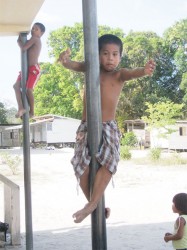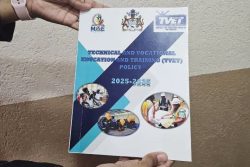Oh Casak!
On the farms, in practically every home, at gatherings in Isseneru, this local beverage runneth over. Refusal of the pinkish beverage made of cassava with potato for colour is not recommended. Be thankful that not all bashwar (bashwar being another name for casak which seems to be indigenous to Isseneru), is created equal.
Maybe one reason for the abundance of bashwar is the heat of Isseneru. In October, the sun beats down on this hilly community of 300 mainly Akawaio Amerindians on the banks of the Mazaruni River, a far way from anywhere. Isseneru is located in the heart of gold-mining country and the village has gotten into this activity with most of the villagers engaged in mining in some form or the other. With other jobs scarce, it is how the villagers make their money.
Mining has helped to develop the community. A multi-purpose centre costing $25 million, a $24 million guest house and a soon-to-be completed benab with costs slated between $20 million to $25 million that would be used for gatherings and a recreation area are some of the initiatives undertaken and funded by the community (a presidential grant of $1.5 million started the multipur-pose centre but the community funded the rest).
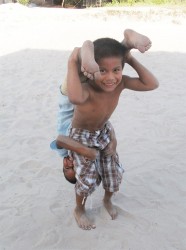
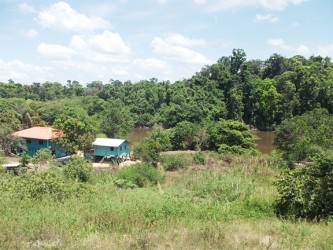
top of one of the many hills at Isseneru
Some villagers have also built modern homes of concrete and zinc. “We want everybody to be happy,” Toshao of the village, Lewis Larson, said during a recent visit to the community. He said that given the scarcity of jobs, the village council tries to create employment. “We assist the least fortunate as well,” he said, pointing out that the council gives social assistance in the form of $10, 000 per month to the less fortunate. In addition, every term $25, 000 is given to the over 14 students who attend secondary school at Bartica. Assistance is also given to the sports club and school while another objective is to improve the homes of the less fortunate, Larson said. They have not done this so far because of limited funds, he added.
If Isseneru seems to have it all, the developments have only come about recently and there are dark sides to the village story.
The Mazaruni River and streams used by villagers have become polluted and a survey just over a decade ago found the majority of villagers surveyed with mercury contamination at dangerously high levels. Mercury is toxic and is widely used in the gold-mining industry and accumulates in the environment including in fish. The study suggested that fish consumption led to the high mercury levels in the residents. An awareness pro-gramme was done but after initially following the guide-lines, the residents seem to have disregarded some of the recommendations.
However, the fish population has also lessened owing to the pollution from river dredging, residents say. In addition, the village has lost two court battles over mining blocks on the community’s titled land and mining activities continue over which they have no control and from which they cannot collect any tribute as would have been the case had the community had control over all their titled land. “I feel we don’t own the land at all,” Larson said. “We can’t mine there, we can’t farm there, we can’t do nothing.”
The operations of the miner have contributed to pollution of the river, but despite reports to the Guyana Geology and Mines Commission, no action was taken, the Toshao said. He added that the mining blocks to which they are forbidden access amount to about a quarter of the community’s titled land.
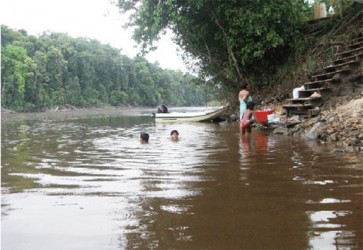
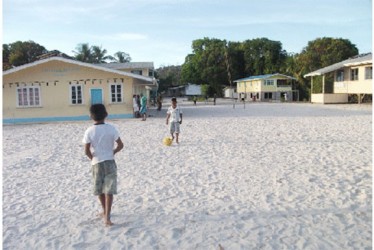
While gold-mining is their major economic activity, farming is still undertaken by many residents with lands close to several houses in the hilly, forested community planted with cassava.
There have been lots of changes in Isseneru, Larson said. He said that there have been improvements to the health centre, the primary school, the playground, the church building, individual houses, transportation and business and communication. He emphasized that most
of the developments were community efforts except for the school building, the health centre and teacher’s quarters which were funded by the government.
In the past, people moved about with canoes but now actually everyone has an outboard engine, Larson said. Some people have their own radio sets while an internet system was donated by a private organisa-tion but it is not functioning and they are looking to have this fixed, he said.
“The community is now a growing community in terms of population and every other thing,” said Cedrick Wilkey, a teacher at the Isseneru Primary School. But while it develops, the indigenous culture is dying with most of the young people not in tune with their customary way of life, he said, adding that some no longer understand the Akawaio language.
Benjamin Ritchie, originally from Sand Creek, Region Nine, moved to the community in 1981 from Kurupung. “It was not like this village… we come as a group of families,” he said, adding that about eight families originally settled the area. He said that the Akawaios moved up and down the area but found the location better and eventually established permanent settlements. “It is much more better than other places,” Ritchie said, stating that the fish were bigger and the land was
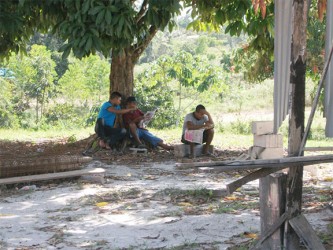
better than in the Upper Mazaruni.
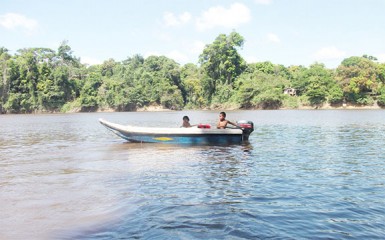
Jacqueline Joseph, the health worker said that the village which is ‘Issululu’ in Akawaio means ‘mass grave.’ She said that, in the past, people died one after the other because of an unknown illness, hence the name. The village is located approximately 15-20 miles west of Kurupung and is accessed from the coast via aircraft to Olive Creek then an hour-long boat ride up the Mazaruni to Isseneru. There is also a road up to Olive Creek from the lower Mazaruni or alternatively a jet-boat from Parika to Isseneru, a trip which can take a day. Joseph said that villagers still suffer from malaria and sometimes they do not get drugs on time.
The community has one church and it is the Alleluia church. Adherents worship on Saturdays and Sundays. Joseph said that other denominations also pray in the same building with, for example, Seven Days Adventists, holding a service after the Alleluia service on Saturday and Anglicans holding their services after the Alleluia service on Sunday.
Like many other families, Joseph is involved in mining. She said that her husband does mining while she also plants vegetables, ground provisions and other crops. Mining is positive because it brings an income to families, she said, noting that the cost of living is also high. Despite the high cost of living, she said that she loves her village. “This place is quiet, not too busy like many other communities and most of all, the farmland is very fertile,” she said.
“We do mining because we see other miners benefiting. We do it because we too want to benefit from it also. So it’s not like something unfair,” said Shawn Joseph called ‘Sean Paul’ or ‘Sean P.’
Mining has also brought some challenges, particularly social, said Larson. He related that because the landings are very close, when the young people return from the backdam, they go straight to the landings where there is prostitution,
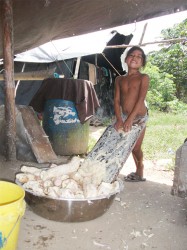
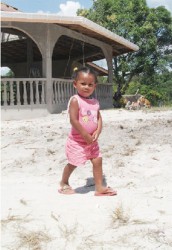
alcohol and drugs being sold. Most young people consume alcohol, he said. The Toshao said that they are trying to encourage persons to focus on farming so that they can supply people, including miners.
Larson was elected Toshao in April last year and previously served from 2002-2007. The village owns two excavators which are rented to miners from the village. Miners on the community’s titled land pay a 12% tribute to the village council.
The village leader said that the council is working towards further improvements. Very soon the community will receive electricity, he said. The previous council had purchased a generator and they now have to get an electrician to install the wiring. He said that they have tried to get some assistance from the Ministry of Amerindian Affairs in terms of cables and an electrician to install the generator but have not gotten a response.
Nevertheless, he said, the council will go ahead and see how they can get it done.
